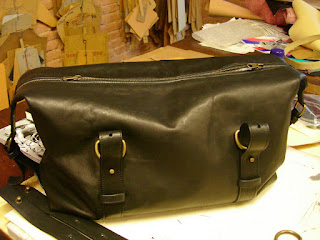I have been carrying the first bag I completed and it is an incredible sense of accomplishment. I love seeing the look on people's faces when I tell them I made it. Some people simply do not believe me, which is a very good sign. Very soon, those of you in NY will get to see it in person.

These are the pattern pieces for Borsa #2. I am attached to my Filson field bag, so I am making a bag that resembles it, of course with some very important modifications.

I am delighted to say that there are some things I can do in my sleep now, like the interior zippered pockets that used to take me half a day to insert.

The construction of this bag is quite different from the others I've done. As always, we work from the interior out, so I started with the lining. Pictured above is the lining of what will be the exterior pocket, attached to the leather which is part of the exterior of the bag.

Tracolla attached to the quadrante (main part)

These are the things you will never see unless you cut open a bag. This is reinforcement on the interior where the handles attach to the "quadrante of the bag. Once stitched down, I have to pull the threads tight, knot them, and glue "seta" (silk) on top to secure them in place. The "fodera" (lining) will hide this later. You can see there is a piece of "felpa" (the cream colored fabric) which gives the leather a little more "corpo," which means literally, body. Without it, the leather would be flimsy and would not give enough support to the bag.

My machine stitching has come a long way since the days when Acci used to eat my bag. The small cuts in the leather that you see on the upper right hand corner are the "segni" which are markings that will line up with the corresponding parts. I use them as a guide to connet the pieces when I am stitching them together.

As I mentioned before, the construction of this bag is different from the ones I have done. In the earlier models, I completed the entire lining, followed by the exterior, and then would stitch the two separate components together to make one complete form. In this bag the pieces of the lining correspond directly with the leather pieces of the exterior, and I attached them to their corresponding parts. The lining overlaps with the adjacent lining pieces, and each leather piece "sandwiches" on top of the next, so I can stitch them down and have a finished seam. If you look at the photo you can see that I am constructing the exterior in almost a ring form, so I can then attach the quadrante to both sides. This will all make much more sense when you see the next series of photos, I promise!
My days are winding down here, and I will be going home next week with my handmade creations in tow. I will continue to post from there, as there are many weekend adventures I have not shared with you. There will be at least one more post before I am on my way...










